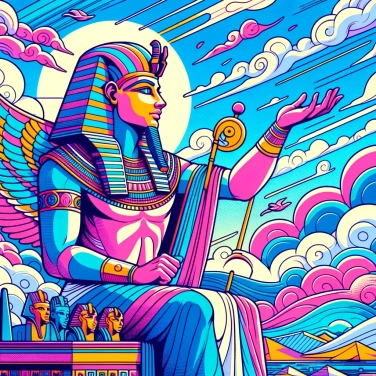Ramses II was one of the most powerful pharaohs due to his victorious military campaigns, significant construction of temples and monuments, and his very long reign of 66 years.

Ramses II was a master of military strategy, capable of effectively leading his armies during memorable battles. His most famous confrontation, the Battle of Qadesh, pitted him against the Hittites and was one of the largest chariot battles in ancient history. Even though the outcome of the conflict was rather indecisive, Ramses II skillfully used it to bolster his prestige in Egypt, proclaiming himself the winner. But the pharaoh also knew when to change tactics: he later signed a famous peace treaty with the Hittites, recognized as one of the earliest official diplomatic agreements in the world. This not only allowed him to avoid costly new battles but also to establish strong international relations, even marrying off foreign princesses to strengthen these alliances. In short, Ramses II combined muscle, cunning, and diplomacy, making Egypt respected and feared by its neighbors.
Ramses II was very focused on expanding his kingdom. During his reign, he led several military campaigns into modern-day Syria, Lebanon, and Palestine to extend his lands and secure Egypt's borders. His victory at the famous Battle of Kadesh against the Hittite Empire (located in present-day Turkey and Syria) helped to consolidate his reputation as a powerful warrior-pharaoh, despite a mixed strategic outcome. Thanks to his keen sense of diplomacy, he subsequently established a peace treaty with the Hittites, one of the earliest known international treaties in history, which durably stabilized the northern part of his empire. Under Ramses, Egypt also controlled a large part of Nubia in the south, which was rich in gold and precious resources. All of this ensured Egypt's dominant position in the region for a long time.
Ramesses II loved to build big and impress everyone, so he multiplied spectacular monuments. Among the most famous is certainly the temple of Abu Simbel, carved into the rock, with its four colossal statues of the seated pharaoh. He is also behind the construction of the Ramesseum, his richly decorated mortuary temple featuring military and religious scenes. He expanded the temple of Amun-Ra at Karnak, adding columns and statues to emphasize his power. He also invested in the construction of the new capital, Pi-Ramses, strategically located to command his territories. Ramesses II loved to engrave his name everywhere to ensure his glory for eternity, and the result is clear: his imprint can still be seen all over Egypt today.
Under Ramses II, Egypt experienced a long period of peace that fostered trade exchanges: there was quite a bit of activity in the markets, with regular trade with neighbors in the Middle East and Africa. This political tranquility allowed for large agricultural harvests, bolstered by an effective irrigation system improved during his reign. Granaries were often full, and Egyptians avoided severe famines. Ramses II developed foreign trade to procure the rare materials needed for his grand projects: gold, ivory, precious woods, and ores arrived regularly in Egypt. Artisans worked at full capacity, driven by the demand for major royal works and new trade exchanges: in short, the economy was booming, and everyone benefited to some extent.
Ramesses II is somewhat the boss of the pharaohs in the Egyptian collective memory. Even during his lifetime, he built his own legend, with the result that people are still talking about him today. His name appears on numerous monuments, statues, and temples that he had constructed all over. Even centuries later, he remains the symbol of a golden age of Egyptian civilization, an ideal era that later generations often look back on with nostalgia. The tales of his military exploits and his incredible, almost divine longevity inspire entire generations. Ramesses is also the model of the perfect and powerful pharaoh: several successors would even take his name in an attempt to capture his glory. And to top it all off, thanks to his exceptionally long reign, he was able to shape cultural and religious life in a lasting way, imposing images of strength, prestige, and royal authority that remain deeply rooted in the Egyptian collective imagination.
The mummy of Ramses II is exceptionally well preserved. Its state of preservation was such that certain physical features of the famous pharaoh could be clearly identified.
Ramses II was so popular and revered that several centuries after his death, subsequent pharaohs sometimes chose his name as a symbolic reference to reinforce their legitimacy and power.
The famous Battle of Kadesh, led by Ramses II against the Hittite Empire, gave rise to the first known peace treaty in history, often referred to as the Treaty of Kadesh.
Ramses II is known to have had over 100 children, which also symbolized his power and ensured a strong succession for his dynasty.
Among his numerous architectural achievements, the rock-cut temple of Abu Simbel remains one of the most famous monuments of Ramses II.
Although not explicitly named in the Bible, some historians associate Ramses II with the pharaoh in the story of Moses and the Exodus, but this identification remains a subject of debate.
Ramses II was nicknamed 'Ramses the Great' due to the exceptional length of his reign, his remarkable military successes, his impressive monumental projects, and his lasting legacy on ancient Egypt and its culture.
Under Ramses II, Egypt asserted its control over Nubia to the south, as well as various regions in Syria and Palestine, particularly after the Battle of Kadesh against the Hittites.
Ramses II died at the advanced age of around 90, likely of old age. His body was buried in the Valley of the Kings, before being moved several times by Egyptian priests to prevent looting. Today, his mummy is preserved in the Egyptian Museum in Cairo.
Ramses II had one of the longest reigns in Egyptian history, ruling for about 66 years, from 1279 to 1213 BC.

No one has answered this quiz yet, be the first!' :-)
Question 1/5